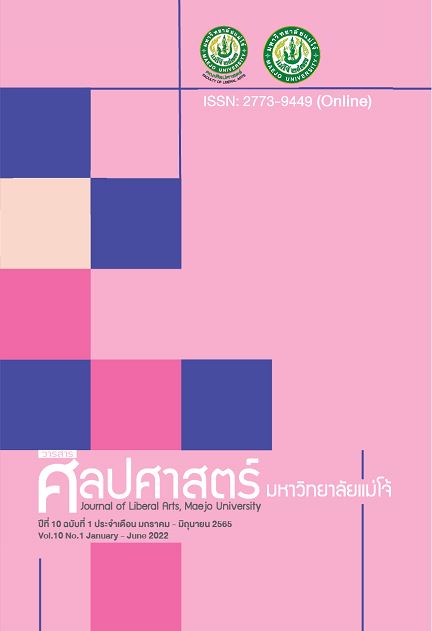Communicative Elements and Linguistic Strategies for Commenting on Depression Pages: A Discourse Analysis and Pragmatics Approach
Main Article Content
Abstract
Major depressive disorder is a disease affecting the mind and work of many
people in Thai society, nowadays. This research article aimed to analyze communicative components and linguistic strategies for commenting on depression pages. Data were collected from “Letter from Depression Page” and “Beloved Depression Page (Suemsaoteerak Page)” from November 1, 2019 - May 30, 2020. The analysis results revealed that in terms of the communicative elements about depression, a facebook page is a new medium, called “facebook discourse”, and it is the space for a group of people with the same objective used to express their opinions and attitudes. A tone of understanding and concern, affecting the norms of interactions and interpretations was used to convey stories and encourage patients with major depressive disorder. Thirteen linguistic strategies, namely expressing the feelings and needs of commenters, giving encouragement, comparing, agreeing with posts, giving reasons, disagreeing, complaining, mentioning the events or experiences of the commenters, asking for advice, giving advice, asking for sympathy, rhetorical
questions and reprimanding were used. These linguistic strategies reflected the
thinking of people with depression and also showed empathy as friends or consultants of the communication event participants with and without major depressive disorder. Therefore, the depression pages on Facebook are not only responsible for creating understanding between patients and communication event participants, but also creating understanding for the people in society because remedial treatment of patients with major depressive disorder requires cooperation among health workers, patients, family and society.
Article Details

This work is licensed under a Creative Commons Attribution-NonCommercial-NoDerivatives 4.0 International License.
ต้นฉบับที่ได้รับการตีพิมพ์ในวารสารคณะศิลปศาสตร์ มหาวิทยาลัยแม่โจ้ ถือเป็นกรรมสิทธิ์ของมหาวิทยาลัยแม่โจ้ ห้ามนำข้อความทั้งหมดหรือบางส่วนไปพิมพ์ซ้ำ เว้นเสียแต่จะได้รับอนุญาตจากมหาวิทยาลัยฯ เป็นลายลักษณ์อักษรReferences
กฤษดาวรรณ หงศ์ลดารมภ์ และ ธีรนุช โชคสุวณิช. (2551). วัจนปฏิบัติศาสตร์. กรุงเทพฯ: โครงการเผยแพร่ผลงาน
วิชาการ คณะอักษรศาสตร์ จุฬาลงกรณ์มหาวิทยาลัย.
กสทช. (2562). เทคโนโลยีอินเทอร์เน็ตกับการมีส่วนร่วมทางการเมืองไทยในระบอบประชาธิปไตย. สืบค้น 18 พฤษภาคม 2563, จาก https://bit.ly/3bGW9kj.
คันธรส สุขกุล และ ปราโมทย์ วงสวัสดิ์. (2562). ภาวะซึมเศร้าในประชากรวัยแรงงาน: ปัจจัยที่เกี่ยวข้องและแนวทางการดูแล. วารสารวิทยาลัยพยาบาลพระปกเกล้า. 30(2), 229-238.
จันทิมา อังคพณิชกิจ อธิชาติ โรจนะหัสดิน และทรงพล อินทเศียร. (2563). ภาษา การสื่อสารและโรคซึมเศร้า: การสำรวจเบื้องต้นเพื่อเข้าใจโรคซึมเศร้าและผู้มีภาวะซึมเศร้าในสังคมไทย. กรุงเทพฯ: อมรินทร์ พริ้นติ้ง.
ณัฐพร พานโพธิ์ทอง. (2549). มองคัทลียาจ๊ะจ๋า จากมุมนักภาษา: เนื้อหาและกลวิธี. กรุงเทพฯ: โครงการเผยแพร่ผลงานวิชาการ คณะอักษรศาสตร์ จุฬาลงกรณ์มหาวิทยาลัย.
ณัฐพร พานโพธิ์ทอง. (2555). เอกสารคำสอนรายวิชา 2201783 การวิเคราะห์ภาษาไทยตามแนววัจนปฏิบัติศาสตร์ (ฉบับปรับปรุง). ภาควิชาภาษาไทย คณะอักษรศาสตร์จุฬาลงกรณ์มหาวิทยาลัย. (อัดสำเนา).
ณัฐพร พานโพธิ์ทอง. (2556). วาทกรรมวิเคราะห์เชิงวิพากษ์ตามแนวภาษาศาสตร์: แนวคิดและการศึกษาวาทกรรมในภาษาไทย. กรุงเทพฯ: โครงการเผยแพร่ผลงานวิชาการ คณะอักษรศาสตร์ จุฬาลงกรณ์มหาวิทยาลัย.
ตฤณธวัช วงษ์ประเสิรฐ และ กุลทิพย์ ศาสตระรุจิ. (2559). ทัศนคติและพฤติกรรมการใช้งานเฟซบุ๊กของวัยทำงานในกรุงเทพมหานคร. วารสารนิเทศศาสตร์และนวัตกรรม นิด้า. 3(2), 29-46.
ธรณินทร์ กองสุข. (มปป.). โรคซึมเศร้ารักษาหายได้. พิมพ์ครั้งที่ 10. อุบลราชธานี: ศิริธรรมออฟเซ็ท
นันทภัค ชนะพันธ์. (2563). ผู้ป่วยโรคซึมเศร้า: บทบาทพยาบาลในการดูแลเพื่อส่งเสริมการดูแลตนเองของผู้ป่วย.
วารสารพยาบาลศาสตร์ จุฬาลงกรณ์มหาวิทยาลัย. 32 (1), 75-88.
นันทิรา หงศ์ศรีสุวรรณ์. (2559). ภาวะซึมเศร้า. สืบค้น 15 พฤษภาคม 2563, จาก https://bit.ly/2Z8Fx2a.
ยงยุทธ วงศ์ภิรมย์ศานติ์. (2563). การดำเนินงานสุขภาพจิตภายใต้วิกฤตโควิด 19 ของประเทศไทย. วารสารสุขภาพจิตแห่งประเทศไทย. 28 (4), 280-291.
ยุบล เบ็ญจรงค์กิจ, ธีรดา จงกลรัตนาภรณ์, ประภัสสร จันทร์สถิตพร และ พรทิพย์ ชนะค้า (2552). การใช้การสื่อสารแบบไวรัลผ่นทางฟอร์เวิร์ดเมลและผลการตอบสนองของผู้รับสาร. สืบค้น 18 พฤษภาคม 2563, จาก https://bit.ly/2LBZmXL.
ราชบัณฑิตยสภา. (2556). พจนานุกรมศัพท์ฉบับราชบัณฑิตยสถาน พ.ศ. 2554. กรุงเทพฯ: นานมีบุ๊คส์พับลิเคชั่นส์.
วิศปัตย์ ชัยช่วย. (2551). เนื้อหาของสารสนเทศในบอร์ดหาคู่สนทนาทางอินเทอร์เน็ต. สืบค้น 18 พฤษภาคม 2563, จาก https://bit.ly/2X2PxHE.
ศตวรรษ จำเพียร และ ณัฐพล อัสสรัตน์. (2562). อิทธิพลของคุณประโยชน์ของเฟซบุ๊กแฟนเพจต่อความเชื่อมมั่นแลความยึดมั่นในแบรนด์: กรณีศึกษาเฟซบุ๊กแฟนเพจร้านอาหาร. จุฬาลงกรณ์ธุรกิจปริทัศน์. 41(161), 133-164.
ศิริพร จิระวัฒน์กุล, สมพร รุ่งเรืองกลกิจ, ธรณินทร์ กองสุข และจรูญศรี มีหนองหว้า. (2541). การพัฒนากลวิธีและเทคโนโลยีส่งเสริมสุขภาพจิตเพื่อป้องกันโรคซึมเศร้าในประชาชนทั่วไปและกลุ่มเสี่ยง. สืบค้น 16 พฤษภาคม 2563, จาก https://bit.ly/3bCvrcy.
สถิตย์ วงศ์สุรประกิต และสมพร สันติประสิทธิ์กุล. (2555). สถานการณ์โรคซึมเศร้าในกลุ่มเสี่ยงโดยการตรวจคัดกรองในเขตอำเภอเมือง จังหวัดเชียงราย. วารสารสภาการพยาบาล. 27(3), 91-105.
สาธารณสุข, กระทรวง. (2564). รายละเอียดตัวชี้วัด กระทรวงสาธารณสุข ประจำปีงบประมาณ 2564. (อัดสำเนา)
สาวิตรี วิษณุโยธิน และ นชพร อิทธิวิศวกุล. (2553). แนวทางเวชปฏิบัติการดูแลผู้มีภาวะซึมเศร้า. วารสารวิทยาลัยพยาบาลบรมราชชนนี นครราชสีมา. 16(1), 5-22.
สุขภาพจิต, กรม คณะทำงานจัดทำแนวทางการจัดการโรคซึมเศร้าสำหรับเวชปฏิบัติทั่วไปในสถานบริการระดับปฐมภูมิและทุติยภูมิ. (2553). แนวทางการจัดการโรคซึมเศร้า. กรุงเทพฯ : กระทรวงสาธารณสุข.
สุขภาพจิต, กรม ราชวิทยาลัยกุมารแพทย์แห่งประเทศไทย ชมรมจิตแพทย์เด็กและวัยรุ่นแห่งประเทศไทย และสถานบันสุขภาพจิตเด็กและวัยรุ่นราชนครินทร์. (2560). แนวทางการดูแลวัยรุ่นที่มีภาวะซึมเศร้า. กรุงเทพฯ : กระทรวงสาธารณสุข.
สุจริตลักษณ์ ดีผดุง. (2552). วัจนปฏิบัติศาสตร์. พิมพ์ครั้งที่ 2. กรุงเทพฯ: ห้างหุ้นส่วนจำกัดสามลดา.
สุรีรักษ์ วงทิพย์. (2561). เครือข่ายสังคมออนไลน์: กลยุทธ์การสื่อสารการตลาดออนไลน์เพื่อดึงดูดผู้บริโภคในยุคดิจิทัล.
วารสารบริหารธุรกิจเทคโนโลยีมหานคร. 15(1), 21-36.
Angkapanichkit, J. (2014). The Ethnographic Discourse Analysis of Health Communication on Depression in Thailand.Paper presented in Proceedings 12th Asia Pacific Sociological Association (APSA)
Brown, G. and Yule, G. (1983). Discourse Analysis. Cambridge: Cambridge University Press.
Davis, B and J. P. Brewer. (1997). Electronic Discourse: Linguistic Individuals in Virtual Space. New York: State University of New York Press.
Eichstaedt C, J. et all. (2018). Facebook language predicts depression in medical records. Retrieved March 25, 2021, from https://www.researchgate.net/publication/328299901_ Facebook_language_predicts_depression_in_medical_records.
Floyd. (2018). Facebook Interactions: An Ethnographic Perspective. Retrieved March 29, 2021
from https://journals.sagepub.com/doi/full/10.1177/2056305118784776.
Georgalou. (2017). “This is a wall of memories: Time and Age Identity in Facebook Discourse.” In
S. Leppänen, E.Westinen and S. Kytölä (eds.). Social Media Discourse, (Dis)identifications
and Diversities. New York: Routledge, 235-262.
Harris. (1951). Methods in Structural Linguistics. Chicago: University of Chicago Press.
Hastings. (2019). Benefits of Ethnography of Communication for Mental Health Professionals. Retrieved March 29, 2021 from https://bit.ly/3rtSXjP
Herring. (1996). Computer-mediated Communication. Linguistics, Social and Cross-Cultural Perspectives. Amsterdam, Philadwlphia: John Benjamin.
Herring. (2004). Computer-Mediated Discourse Analysis: An Approach to Researching Online Behavior. Designing for Virtual Communities in the Service of Learning. Retrieved March 20, 2021, from https://www.researchgate.net/publication/285786435. Horn, L and Ward, G. (2006). The Handbook of Pragmatics. Victoria: Blackwell Publishing.
Hymes, D. (1974). Foundation of Sociolinguistics: An Ethnographic Approach. Philadelphia: University of Pennsylvania Press.
Lakoff and Johnson. (1980). Metaphors We Live By. Chicago & London: The University of Chicago Press.
Leppänen, S., Westinen, E., and Kytölä, S. (2017). Social Media Discourse, (Dis)identifications and Diversities. New York: Routledge
Noy, C. (2017). “Ethnography of Communication”. in Matthes, J. (ed.). The InternationalEncyclopedia of Communication Research Methods. NY: John Wiley & Sons, Inc, 1-11.
Schiffrin. (1987). Discourse Markers. Cambridge: Cambridge University Press.
Stubbs. (1983). Discourse Analysis: The sociolinguistic analysis of natural language. Chicago: The University of Chicago Press.

